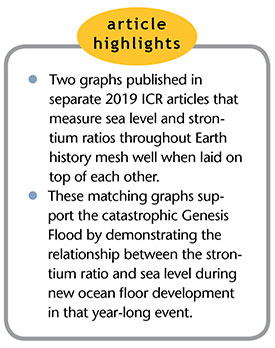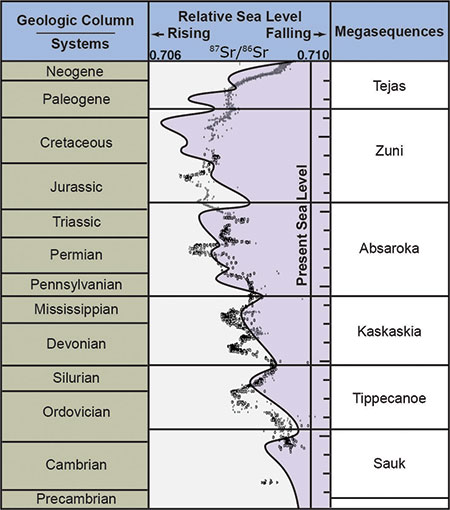Vernon R. Cupps, Ph.D., and Tim Clarey, Ph.D.
 The October 2019 issue of Acts & Facts ran an article on the variation of the 87Sr/86Sr ratio in marine rocks.1 One of our readers noticed a similarity between the 87Sr/86Sr graph in that article and the megasequence/geological column graph of relative sea levels that first appeared in the February 2019 issue.2,3 When placed together on the same secular timescale, the Figure 1 dual graph is the result.
The October 2019 issue of Acts & Facts ran an article on the variation of the 87Sr/86Sr ratio in marine rocks.1 One of our readers noticed a similarity between the 87Sr/86Sr graph in that article and the megasequence/geological column graph of relative sea levels that first appeared in the February 2019 issue.2,3 When placed together on the same secular timescale, the Figure 1 dual graph is the result.
Using the secular timescale on the left side, sea level steadily increased from the Precambrian era (~540 million years ago) until the end of the Cretaceous system (~66 million years ago). This was based on the progressive continental sediment coverage we observed.3 Global sea level shows a precipitous decrease from the Cretaceous system to the late Neogene system (~2.5 million years ago). The accompanying rise in the 87Sr/86Sr ratio is typically interpreted as reflecting the uplift of the Himalayas during the Paleogene system.4
Veizer and Mackenzie4 conclude this ratio is primarily controlled by two sources: the “mantle” (formation of ocean crust) and the “river” flux.5 When combined, these two sources can be placed in a balance equation with approximately 75% coming from the river sources and 25% coming from the mantle sources, to give the value of 0.7092. If one assumes Figure 1 represents 540 million years, then one is forced to conclude the balance between mantle and river flux contributions to the ratio was in continual change for those 540 million years, with the mantle contribution dominating the river contribution. However, over millions of years, one would expect a more uniform change in the sea level, and especially in the strontium ratio.

These two data sets appear to support several conclusions:
- Like the strontium ratio, the sea’s final level is approximately the same as where it started. This better represents a catastrophic flood thousands of years ago rather than millions of years of slow variation.
- The strontium isotope ratios seem to be strongly influenced by the formation of new ocean crust during the Flood, with the lowest ratios corresponding to the maximum volume of seafloor formation. The formation of new, hot ocean crust pushes up the sea bottom and raises global sea level.
- The timing of formation of maximum ocean crust corresponds with the highest sea level. This is what we would expect to occur in the Flood year.
- It also indicates that a decrease in the 87Sr/86Sr precedes a significant rise in sea level. Could this indicate significant volcanic activity (the fountains of the deep breaking up in Genesis 7:11) from the lower crust/upper mantle before a significant rise in sea level?
- Note that the maximum sea level is attained at the end of the Cretaceous system—the K-T or K-Pg boundary. In a biblical interpretation, this would be the peak of Noah’s Flood (Genesis 7:19).
- In a biblical worldview, the Paleogene and Neogene systems represent a floodwater recession period, finally returning the isotope ratios and sea level to their pre-Flood values (Genesis 8:2-3).
- Thus, in a biblical worldview, Earth dried and Noah emerged from the Ark sometime near the end of the Neogene system.
The strontium isotope ratio for seawater better supports the biblical catastrophic megasequence interpretation of Earth history rather than the conventional hundreds of millions of years view.
References
- Cupps, V. R. 2019. Strontium Ratio Variation in Marine Carbonates. Acts & Facts. 48 (10): 9-10.
- M. Luebke email communication to the Acts & Facts editor on September 23, 2019.
- Clarey, T. 2019. A Rock-Based Global Sea Level Curve. Acts & Facts. 48 (2): 9-10.
- Veizer, J. and F. T. Mackenzie. 2013. Sediments, Diagenesis, and Sedimentary Rocks. 7.15.11.2.1. In Treatise on Geochemistry, 2nd ed. H. D. Holland and K. K. Turekian, eds. Amsterdam, Netherlands: Elsevier Science.
- The former can be thought of as strontium exchanged between seawater and the oceanic crust with an average 87Sr/86Sr ratio of ~0.703. The latter is viewed as reflecting the more fractionated composition of the continental crust that feeds more 87Sr into the oceans via rivers. In 1989, the average strontium isotope ratio for rivers was estimated to be ~0.712. See Palmer, M. R. and J. M. Edmond. 1989. The strontium isotope budget of the modern ocean. Earth and Planetary Science Letters. 92 (1): 11-26.
* Dr. Cupps is Research Associate at the Institute for Creation Research and earned his Ph.D. in nuclear physics at Indiana University-Bloomington. Dr. Clarey is Research Associate at the Institute for Creation Research and earned his Ph.D. in geology from Western Michigan University.











